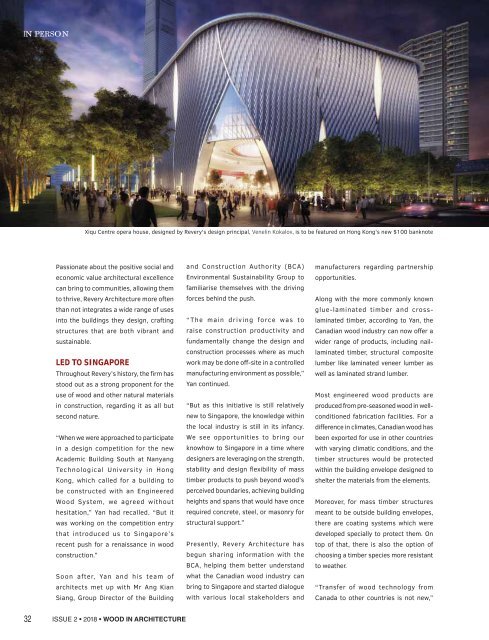Wood In Architecture Issue 2, 2018
First published in 2017, Wood in Architecture (WIA) is a bi-annual trade magazine devoted to the international timber construction sector. The newest addition to the Panels & Furniture Group of wood magazines, WIA features in-depth insights to the latest industry news, incredible projects and leading trade events. WIA is an advocate for timber as a material of choice for today’s built environment, and is the perfect source of inspiration for architects, builders, engineers and interior designers across the globe.
First published in 2017, Wood in Architecture (WIA) is a bi-annual trade magazine devoted to the international timber construction sector. The newest addition to the Panels & Furniture Group of wood magazines, WIA features in-depth insights to the latest industry news, incredible projects and leading trade events. WIA is an advocate for timber as a material of choice for today’s built environment, and is the perfect source of inspiration for architects, builders, engineers and interior designers across the globe.
You also want an ePaper? Increase the reach of your titles
YUMPU automatically turns print PDFs into web optimized ePapers that Google loves.
IN PERSON<br />
Xiqu Centre opera house, designed by Revery's design principal, Venelin Kokalov, is to be featured on Hong Kong's new $100 banknote<br />
Passionate about the positive social and<br />
economic value architectural excellence<br />
can bring to communities, allowing them<br />
to thrive, Revery <strong>Architecture</strong> more often<br />
than not integrates a wide range of uses<br />
into the buildings they design, crafting<br />
structures that are both vibrant and<br />
sustainable.<br />
LED TO SINGAPORE<br />
Throughout Revery’s history, the firm has<br />
stood out as a strong proponent for the<br />
use of wood and other natural materials<br />
in construction, regarding it as all but<br />
second nature.<br />
“When we were approached to participate<br />
in a design competition for the new<br />
Academic Building South at Nanyang<br />
Technological University in Hong<br />
Kong, which called for a building to<br />
be constructed with an Engineered<br />
<strong>Wood</strong> System, we agreed without<br />
hesitation,” Yan had recalled. “But it<br />
was working on the competition entry<br />
that introduced us to Singapore’s<br />
recent push for a renaissance in wood<br />
construction.”<br />
Soon after, Yan and his team of<br />
architects met up with Mr Ang Kian<br />
Siang, Group Director of the Building<br />
and Construction Authority (BCA)<br />
Environmental Sustainability Group to<br />
familiarise themselves with the driving<br />
forces behind the push.<br />
“The main driving force was to<br />
raise construction productivity and<br />
fundamentally change the design and<br />
construction processes where as much<br />
work may be done off-site in a controlled<br />
manufacturing environment as possible,”<br />
Yan continued.<br />
“But as this initiative is still relatively<br />
new to Singapore, the knowledge within<br />
the local industry is still in its infancy.<br />
We see opportunities to bring our<br />
knowhow to Singapore in a time where<br />
designers are leveraging on the strength,<br />
stability and design flexibility of mass<br />
timber products to push beyond wood’s<br />
perceived boundaries, achieving building<br />
heights and spans that would have once<br />
required concrete, steel, or masonry for<br />
structural support.”<br />
Presently, Revery <strong>Architecture</strong> has<br />
begun sharing information with the<br />
BCA, helping them better understand<br />
what the Canadian wood industry can<br />
bring to Singapore and started dialogue<br />
with various local stakeholders and<br />
manufacturers regarding partnership<br />
opportunities.<br />
Along with the more commonly known<br />
glue-laminated timber and crosslaminated<br />
timber, according to Yan, the<br />
Canadian wood industry can now offer a<br />
wider range of products, including naillaminated<br />
timber, structural composite<br />
lumber like laminated veneer lumber as<br />
well as laminated strand lumber.<br />
Most engineered wood products are<br />
produced from pre-seasoned wood in wellconditioned<br />
fabrication facilities. For a<br />
difference in climates, Canadian wood has<br />
been exported for use in other countries<br />
with varying climatic conditions, and the<br />
timber structures would be protected<br />
within the building envelope designed to<br />
shelter the materials from the elements.<br />
Moreover, for mass timber structures<br />
meant to be outside building envelopes,<br />
there are coating systems which were<br />
developed specially to protect them. On<br />
top of that, there is also the option of<br />
choosing a timber species more resistant<br />
to weather.<br />
“Transfer of wood technology from<br />
Canada to other countries is not new,”<br />
32 ISSUE 2 • <strong>2018</strong> • WOOD IN ARCHITECTURE


















